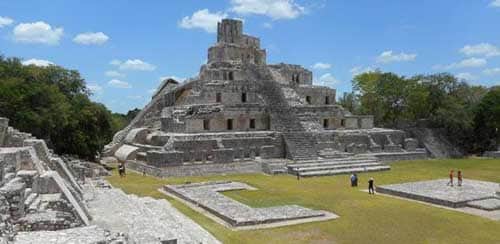For the past four years an archaeology project has been continuing in the Mayan city of Uxul in Campeche, Mexico.
The dig, undertaken by the Mexican National Institute of Anthropology and the Archaeologists from the Department of Anthropology of the Americas at the University of Bonn, has been under the direction of Prof. Nikoai Grube and Dr. Kai Delvendahl. The excavation was initiated to investigate the process of centralization and collapse of hegemonic state structures in the Maya lowlands.
Since 2011, the dig has concentrated on the royal palace complex. That complex is located to the south of the main plazas in the center of Uxul. The complex was built around 650 AD. This was around the time that a neighboring ruling dynasty, known as the Calakmul, was influential around the Mayan lowlands.
A further discovery of panels in 2011 during the excavation of the southern stairway of Structure K2, the largest building of the group was taking place, further cemented the idea that at one point, the city of Uxul, thought to have had its beginnnings as a smaller independent city, for a time was ruled by the Kaan Dynasty of the Calakmul. In four of the six panels, Calakmul kings were depicted playing ball.
|
|
“During this year´s excavation below one of the southern rooms of Structure K2, we have discovered a richly furnished tomb, which can be dated to the time right after the influence of Calakmul in Uxul had ended” explains Dr. Delvendahl. The walls of the crypt are made of rough stone and the chamber was covered with a corbel vault, typical for the Maya culture. In the interior of this tomb chamber which dates back about 1,300 years, the remains of a young man were discovered who was buried on his back with his arms folded. Deposited around him were four ceramic plates and five ceramic vases in an exceptionally preserved state, some of which were decorated with spectacular paintings and moldings. A unique plate, painted in the famed Codex-Style, was covering the skull of the deceased.
“On one of the vases, there was a simple dedication, written in elegantly molded hieroglyphics, which read: ‘[This is] the drinking vessel of the young man/prince’. Also a second molded vessel appears to mention a young man or prince” says Professor Grube. Although these references are not definite clues as to the identity of the departed, the location of the tomb and the absence of certain status markers, such as jade jewelry, would indicate that the deceased was a young male member of the ruling family who was not in direct line for the throne. A possible date on one of the vessels corresponds to the year 711 AD; therefore the death of the young prince and the construction of his tomb can be dated back to the second or third decade of the 8th century. The exceptionally preserved ceramics in particular make this tomb one of the most significant discoveries of its kind in the entire Maya Lowlands.



